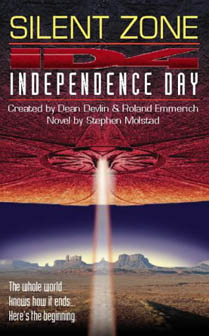To celebrate the 20th anniversary of “Independence Day” and the release of the sequel, “Resurgence,” this week I’m looking back at the various spinoff comics and novels. All of these spin-off materials were recently released (or re-released, in the case of the old stuff) by Titan Books. Also, check out my reviews of “Independence Day” and “Independence Day: Resurgence.”
As discussed in my last post, Phil Crain’s Issue No. 0 prequel comic gave a broad, not-very-satisfying backstory to Dr. Brakish Okun and the Area 51 project. An Army scientist named Dr. Rose studied the alien ship for two decades, then handed the reins to Dr. Okun, who studied it for another two decades, leading up to the events of the movie.
After the movie became a huge hit, “ID4” creators Dean Devlin and Roland Emmerich opted to give a deeper backstory to Okun and the project, commissioning Stephen Molstad’s 1997 prequel novel, “Silent Zone.” Some broad details are the same: For example, Okun is still a student at CalTech when the government recruits him. However, Molstad creates a meatier backstory about the government’s interaction with and knowledge of the aliens – called “eebies” here, a play on extraterrestrial biological entity. Although it’s sloppy from a continuity standpoint that Issue 0 gets scrapped a mere year after its publication, I forgive the decision because “Silent Zone” is so much better.
“Silent Zone” is largely written in an information-dump style, yet it works as a page-turner for two reasons. One, Dr. Okun (played by Brent Spiner in the movie) has an entertaining personality. He’s not altruistic, nor is he self-centered; he’s simply obsessed with scientific knowledge and says hippie things like “groovy.” Rather than Crain’s idea of a lonely scientist in the bowels of Area 51, Okun – who joins the team in 1972 (contrasting with the 1967 date of the comic) – is welcomed into the cadre of eccentric 70-something scientists who have been there since the beginning.
Often times, we think of government conspiracy stories as starring two groups: those in the loop and those out of the loop. “Silent Zone” puts Okun and the Area 51 scientists in the middle. Yes, they are allowed to study the ship, but on the other hand, the government spooks – led by Nimziki, the only human villain in the first movie — withhold their knowledge of a second ship. (Although Nimziki maneuvers things so he has control of Area 51, he is not the director of the CIA as he is in Issue 0; indeed, President Ford passes him over for that position at the end of the novel.)
When Okun and his team realize the ship’s energy source needs to operate in unison with another ship, it leads them on a quest to uncover that ship’s whereabouts, eventually taking them to the Silent Zone in Mexico – a place where radio signals are blocked. The scientists also clash with their higher-ups over money and equipment, leading them to cash their dead colleagues’ paychecks and become Vegas cardsharps to pad their funding.

“Silent Zone” explores “X-Files”-style notions without feeling like a ripoff, because it hews so closely to the spacecraft and the eebies. A disgraced former Area 51 scientist, Dr. Wells (spelled “Welles” in the “ID4” novelization that was released before this prequel novel), believes Earth must prepare for an alien invasion and that people have the right to know about it. One hallway of the Area 51 bunker is filled with boxes of Wells’ unorganized files about the early studies of the eebies.
Molstad structures the book in a Russian nesting egg style where Okun opens up one of these old files and then we get the flashback story. Whereas “The X-Files” and “Roswell” used the 1947 New Mexico crash to immediately branch off into its own stories, “ID4” uses the entirety of the Roswell lore and other real-world abduction cases as unadorned background. The ships and eebies specific to “ID4” are the elements where it branches off into a fictional narrative. “Silent Zone” also taps into verifiable history such as the Bikini Atoll bomb tests to enrich the 1947 alien-visitation narrative.
In light of “Resurgence,” “Silent Zone” plays as the first part of a grand narrative outlined by Devlin and Emmerich, as big story elements are teased here: The mysterious symbols on the spacecraft, the fact that the eebies come from a planet thick with vegetation, and the fact that they desire something underneath the surface of planets. It’s clear in the first film that the eebies live inside the organic shell of a bigger alien, and that concept is fleshed out in “Silent Zone.” The book also makes it clear that the ships are organic. And Wells correctly guesses that the eebies are part of a hive mind, a point that’s crucial in “Resurgence.”
From a character standpoint, Okun meets Dr. Isaac (spelled Issac in the book) here; although Isaac is in the first movie, the Okun-Isaac romantic relationship isn’t revealed until “Resurgence.” Okun has a crush on a young woman in “Silent Zone,” perhaps suggesting that Devlin and Emmerich decided to make Okun gay later on, although one could plausibly argue that it’s not a continuity error because Okun is bisexual.
Overall, “Silent Zone” greatly enriches the “ID4” mythos by showing that Okun isn’t just a stir-crazy man who is immediately shown up by Jeff Goldblum’s David Levinson, but instead someone who did brilliant work anticipating the alien invasion – from determining how the ships draw energy to pushing for an emergency exit door, should humans ever need to fly it out of Area 51. Although he technically is part of the cover-up that wrongly feels humanity can’t deal with knowledge of aliens, at least he has the decency to struggle with this notion.
If there’s anything disappointing about “Silent Zone,” it’s that it’s entirely a prequel for Okun and Area 51; there’s nothing about Russell Casse’s abduction or Whitmore’s rise through the political ranks. Maybe some of that is explored in the “ID4” novelization.

